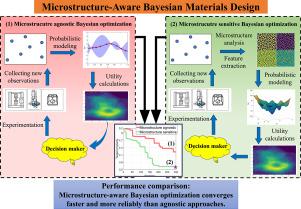微结构感知贝叶斯材料设计
IF 9.3
1区 材料科学
Q1 MATERIALS SCIENCE, MULTIDISCIPLINARY
引用次数: 0
摘要
在这项研究中,我们提出了一种新的微结构敏感贝叶斯优化(BO)框架,旨在通过明确地结合微结构信息来提高材料发现的效率。传统的材料设计方法通常只关注直接的化学-工艺-性能关系,而忽略了微观结构的关键作用。为了解决这一限制,我们的框架将微观结构描述符集成为潜在变量,从而能够构建一个全面的过程-结构-属性映射,从而提高预测准确性和优化结果。通过采用主动子空间降维方法,识别出最具影响的微观结构特征,从而降低了计算复杂度,同时保持了设计过程中的高精度。该方法还增强了高斯过程的概率建模能力,以更少的迭代和实验观察加速收敛到最佳材料配置。我们通过合成和现实世界的案例研究证明了我们的框架的有效性,包括设计用于能量转换的Mg2SnxSi1−x热电材料。我们的研究结果强调了微结构在将加工条件与材料特性联系起来方面的关键作用,强调了微结构感知设计范式在材料发现方面的潜力。此外,这项工作表明,由于结合微观结构意识可以提高贝叶斯材料发现的效率,微观结构表征阶段应该是材料开发自动化和最终自主平台的一部分。本文章由计算机程序翻译,如有差异,请以英文原文为准。

Microstructure-aware bayesian materials design
In this study, we propose a novel microstructure-sensitive Bayesian optimization (BO) framework designed to enhance the efficiency of materials discovery by explicitly incorporating microstructural information. Traditional materials design approaches often focus exclusively on direct chemistry-process-property relationships, overlooking the critical role of microstructures. To address this limitation, our framework integrates microstructural descriptors as latent variables, enabling the construction of a comprehensive process-structure–property mapping that improves both predictive accuracy and optimization outcomes. By employing the active subspace method for dimensionality reduction, we identify the most influential microstructural features, thereby reducing computational complexity while maintaining high accuracy in the design process. This approach also enhances the probabilistic modeling capabilities of Gaussian processes, accelerating convergence to optimal material configurations with fewer iterations and experimental observations. We demonstrate the efficacy of our framework through synthetic and real-world case studies, including the design of MgSnSi thermoelectric materials for energy conversion. Our results underscore the critical role of microstructures in linking processing conditions to material properties, highlighting the potential of a microstructure-aware design paradigm to revolutionize materials discovery. Furthermore, this work suggests that since incorporating microstructure awareness improves the efficiency of Bayesian materials discovery, microstructure characterization stages should be integral to automated—and eventually autonomous—platforms for materials development.
求助全文
通过发布文献求助,成功后即可免费获取论文全文。
去求助
来源期刊

Acta Materialia
工程技术-材料科学:综合
CiteScore
16.10
自引率
8.50%
发文量
801
审稿时长
53 days
期刊介绍:
Acta Materialia serves as a platform for publishing full-length, original papers and commissioned overviews that contribute to a profound understanding of the correlation between the processing, structure, and properties of inorganic materials. The journal seeks papers with high impact potential or those that significantly propel the field forward. The scope includes the atomic and molecular arrangements, chemical and electronic structures, and microstructure of materials, focusing on their mechanical or functional behavior across all length scales, including nanostructures.
 求助内容:
求助内容: 应助结果提醒方式:
应助结果提醒方式:


